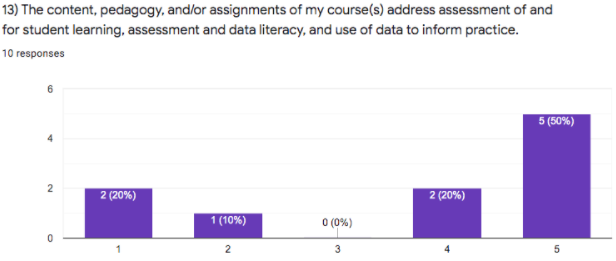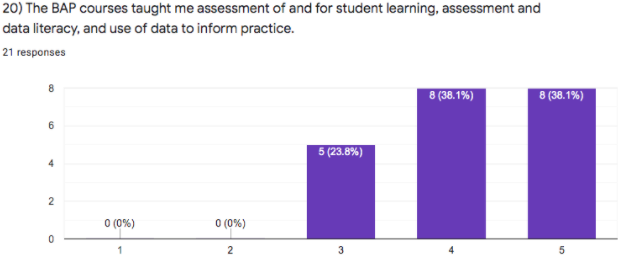AAQEP Accreditation
Standard 1 Aspect D
Standard 1d - Evidence shows that, by the time of program completion, candidates practice with assessment of and for student learning, assessment and data literacy, and use of data to inform practice.
The Bilingual Authorization Program (BAP) selected three different measures to examine how it prepares candidates with practice with assessment of and for student learning, assessment and data literacy, and use of data to inform practice relevant to their preparation as bilingual teacher candidates. The first measure comes from the Spanish lesson plan assignment of the LEE 136 course, the second from the BAP faculty survey, and the third measure comes from the BAP completer survey.
Data Sources & Analysis
Data Source 1
LEE 136: Spanish Lesson Plan
Description of Data Source:
A key assignment from the LEE 136 course for the Spanish BAP pathway that demonstrates
relevant preparation of Spanish bilingual teachers is creating a Spanish lesson plan
that encompasses the tenets of culturally and linguistically sustaining pedagogy around
a central instructional focus or theme and at least one children’s text. The lesson
plan rubric demonstrates alignment between CCSS and language objectives, as well as
the learning tasks, and assessments that are related to an identifiable theme or topic.
The central focus takes into account knowledge of students’ language development,
backgrounds, interests, and learning levels that might further influence students’
thinking and learning. This lesson assignment also embodies the four (4) learning
goals of the course, which include: 1) the impact of language and culture on teaching
and learning in the elementary school, 2) language acquisition theory, socio-cultural
context in teaching and instructional strategies for Emergent Bilinguals in the classroom,
and 3) strategies to promote student success, including achievement of Common Core
state-adopted content and English Language Development (ELD) standards.
Perspective Captured from Data Source: Faculty
Rationale for using Data Source:
The Spanish lesson plan assignment and rubric demonstrate that at the time of completion,
program graduates have practice with designing, implementing, and analyzing student
data that helps them reflect on and improve their practice. Students in this course
begin working on this assignment early on in the semester, workshop their lessons
with each other, and receive feedback from the instructor from inception to implementation.
This layered process allows candidates to thoughtfully incorporate course concepts
and reflect on the strengths and areas for improvement based on the analysis of their
student data.
Specific Elements of Data Source:
Students’ overall grade on assignment
(Unfortunately, scores were not broken down by rubric criterion, and so holistic scores
must be used)
Definition of Success for Each Element:
Programmatically, our goal was for each candidate to score at least an 8 on this assignment
in order to demonstrate competency.
Displays of Analyzed Data:
Table 1: Culturally and Linguistically Sustaining Pedagogy (CLSP) lesson plan scores
| User ID | Culturally & Linguistically Sustaining (CLSP) Lesson Plan |
|---|---|
| Student 1 | 10 |
| Student 2 | 10 |
| Student 3 | 9 |
| Student 4 | 10 |
| Student 5 | 9 |
| Student 6 | 8.5 |
| Student 7 | 10 |
| Student 8 | 10 |
| Student 9 | 8 |
| Student 10 | 10 |
| Student 11 | 10 |
| Student 12 | 8.5 |
| Student 13 | 10 |
| Student 14 | 10 |
| Student 15 | 9 |
| Student 16 | 9 |
| Student 17 | 10 |
| Student 18 | 10 |
| Student 19 | 10 |
| Student 20 | 10 |
| Student 21 | 10 |
| Student 22 | 10 |
| Student 23 | 10 |
*Due to changes in program faculty in recent years, unfortunately, only one cycle of data were available.
Interpretation of Data:
Overall, candidates’ performance on the lesson plan assignment demonstrate that they
were successful in using findings from student assessments to inform their instruction.
Data Source 2
BAP Faculty Survey
Definition of Data Source:
The second source of data comes from the BAP faculty survey that was created and disseminated
for the first time in Spring 2021, with the purpose of examining faculty’s perspectives
on how each course meets the state bilingual authorization standards, as well as AAQEP
standard 1 items a-f.
Starting during the 2021-2022 and thereafter, the results from this survey will be analyzed and discussed in the program advisory meetings to ensure the interest of all stakeholders are represented in coursework and that streamlining of each course is maintained.
For each item, faculty were asked to rate the extent to which they agree with the statement on a Likert scale of 1-5, with 1 being strongly disagree and 5 being strongly agree.
Perspective Captured from Data Source: Faculty
Rationale for using Data Source:
This survey was created to gather faculty members’ perspectives on how well course
content aligns with the aspects of AAQEP Standard 1.
Specific Elements of Data Source:
Item 13: The content, pedagogy, and/or assignments of my course(s) address assessment
of and for student learning, assessment and data literacy, and use of data to inform
practice
Definition of Success for Each Element:
The goal of the program is to have all faculty members strongly agree that their courses
align with the AAQEP Standard 1 aspects.
Displays of Analyzed Data:
Link to Full Dataset: BAP Faculty Survey
Interpretation of Data:
Responses indicate that 70% agreed or strongly agreed and 30% disagreed or strongly
disagreed.
Data Source 3
BAP Completer Survey
Description of Data Source:
The second measure for standard 1c comes from the BAP completer survey completed by
21 graduates for the spring 2021 term. The purpose for this survey is to understand
graduates' experiences in the BAP and Multiple Subject credential program as well
as employment outcomes. Moving forward, data from this survey will be analyzed and
discussed in the program advisory committee meetings with the purpose of making the
necessary changes to improve the program and to better serve our students and the
interests of stakeholders, such as district partners.
Only one (1) year of completer data is available because this is the first time a completer survey was created and disseminated among program graduates. Prior to the new coordinator’s leadership, the BAP was a very small program and no completer data was collected.
Perspective Captured from Data Source: Program Completer
Rationale for using Data Source:
The survey provides information about the program from the perspective of program
completers who are now in the teaching profession.
Specific Elements of Data Source:
Item 20: The BAP courses taught me assessment of and for student learning, assessment
and data literacy, and use of data to inform practice
Definition of Success for Each Element:
Completers are asked to rate the extent to which they agree with each statement on
a 1 (strongly disagree) to 5 (strongly agree) point Likert scale, with the programmatic
goal being a score of 4.
Displays of Analyzed Data:
Link to Full Dataset: BAP completer raw data
Interpretation of Data:
Responses indicate that 76.2% of students agreed or strongly agreed, while 23.8% were
neutral on this statement. The respondents who were neutral on this statement indicate
that program courses needed to incorporate more opportunities for candidates to learn
the assessment strategies specific to the preparation of bilingual/dual immersion
teachers. Course syllabi will be evaluated every semester to ensure there are ample
lectures on assessment types and practice-based assignments for students.
Data Analysis and Next Steps:
Analysis of the BAP faculty and completer survey responses indicate that the program
courses are doing a great job preparing candidates with practice with assessment of
and for student learning, assessment and data literacy, and use of data to inform
practice. However, the 30% of faculty who disagreed or strongly disagreed merit attention
further investigation.
The program will focus on ensuring that we work towards embedding a practice with assessment relevant to the preparation of bilingual/dual immersion teachers in the courses. To evaluate our efforts in this area, the program coordinator will provide curriculum support to all program faculty and will also engage program faculty and advisory board members in yearly curriculum evaluation during program meetings.